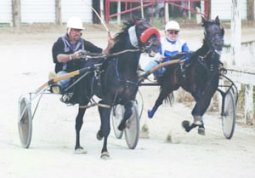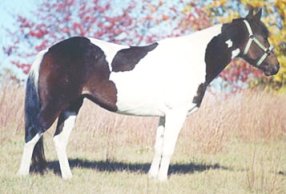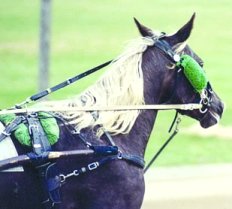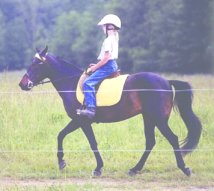
|
Return to Breed Profiles Main Page The Trottingbred - It's Not What You Think! Don't let the name fool you. If the name of the breed makes you think of a diagonally gaited horse you are halfway correct. The other half? They also do lateral gaits. Trottingbreds are harness racing ponies, Standardbred Connection The Standardbred connection is the result of planning with definite goals. In the late 1950's, pony harness races were popular at many county fairs in the Midwest and parts of New England. As the sport grew, enthusiasts wanted to produce a pony with more racing desire and speed. By the early 1960's breeders began crossing their Shetlands, Welshes, Hackneys, Americanas (Shetland/Hackney cross) and grade ponies with Standardbred racers. In 1977, the Trottingbred was officially recognized as a breed by the American Horse Council and is regulated by the International Trotting and Pacing Association (ITPA). Today's Trottingbreds are 3/4 to 7/8 Standardbred. The first significant Standardbred sire was Lothario, a 14 hand son of Florican, out of a Star's Pride mare. He made heavy contributions to the breed, producing speed, desire and both natural pacers and trotters. Other notable Standardbred sires in Trottingbred bloodlines include Super Bowl and Albatross. Built Pony Tough Typical traits include flat, low shoulders, not a problem for driving,
but often a challenge for saddle fit. Hooves are proportional and
hard, and fetlocks tend to be extra profuse. Bay and black are the
most common colors, but they can be found in any color, including
pinto, palomino, grey and roan, though they are much harder to find.
Trottingbreds are naturally good-tempered animals. They can be very sweet and affectionate and genuinely like people. Race training gives them lots of handling and attention that they accept easily. These ponies are tough and long lived, most reaching their twenties. Track injuries may be an issue, but since their racing schedule is seasonal, rather than all year long, they generally stay very sound. Another plus, their smaller size makes them more economical to feed! From Track to Hack Trottingbreds have an amazing amount of stamina, coupled with
a desire to work. Jim Ritter of Indiana recalls being out late at night in a state forest with a group of riders. The other riders requested that he "put that little, black horse up front so we can get home faster". Jim's little, black, Trottingbred gelding hit a quick stepping pace and led the way home. Jim also races pacers and successfully shows his gelding in trail horse classes. Jack Goes, a long time Indiana breeder and racer, who also uses his Trottingbreds under saddle, used to fox hunt on Thoroughbreds. "These ponies are capable enough that on an all-day fox hunt, they keep up," he says. Enthusiasts all stress how sturdy and sound these ponies are, and emphasize that they have tremendous stamina.
Bringing ponies off the track to ride does require some work, but you won't have to teach them to clip, load or behave for the veterinarian or farrier. Being on the road from May to October, track ponies are worked every day, by adults, and tend to have very good manners. Ponies do have to be taught to canter as "breaking stride" is discouraged in racing. Also, racing puts the pony in a hollow frame, head up, in a dead pace. It takes some work to get the pony to round his body and break up the pace. Racing ponies also tend to lean on the bit, which takes some retraining. Track ponies also need to be introduced to scary new things, like traffic, mailboxes, cows and dirtbikes. Best Kept Secret Ride, drive, or race - the versatility is there to do it all with these sturdy American ponies. Keep them in mind the next time you are looking for a smaller, economical, gaited mount. For more information see the ITPA website at www.trottingbred.com, or contact: International Trotting and Pacing Association For sale dates or racing schedules contact Julee Dunagan, ITPA member and liaison at [email protected] |
|||

 which
like their Standardbred forebears, race at either the pace or trot.
Unlike Standardbreds, which are raced over a mile, Trottingbreds
are clocked on the half-mile. The fastest half-mile was paced
in 59 seconds by the stallion, Shamrock Shady. The trotting
record of is 59.2 belongs to the mare Sweet B. Lozario, who
shares the actual race record of 1:01 with Wild Rose. Like
Standardbreds, racing Trottingbreds often find themselves in need
of new employment, and many become nice gaited mounts, suitable
for adults or children.
which
like their Standardbred forebears, race at either the pace or trot.
Unlike Standardbreds, which are raced over a mile, Trottingbreds
are clocked on the half-mile. The fastest half-mile was paced
in 59 seconds by the stallion, Shamrock Shady. The trotting
record of is 59.2 belongs to the mare Sweet B. Lozario, who
shares the actual race record of 1:01 with Wild Rose. Like
Standardbreds, racing Trottingbreds often find themselves in need
of new employment, and many become nice gaited mounts, suitable
for adults or children.
 All
shades of chestnut may be seen, and liver chestnut with a flaxen
mane and tail is currently popular. Trottingbreds with pony breeding
close up tend to grow heavy winter coats. Ponies with more Standardbred
bloodlines tend not to grow as heavy a coat, as heavy coats, being
much harder to cool out, are not bred for in Standardbreds.
All
shades of chestnut may be seen, and liver chestnut with a flaxen
mane and tail is currently popular. Trottingbreds with pony breeding
close up tend to grow heavy winter coats. Ponies with more Standardbred
bloodlines tend not to grow as heavy a coat, as heavy coats, being
much harder to cool out, are not bred for in Standardbreds. These
are not lazy ponies. If they liked racing, as many do, they
seem to transfer their enthusiasm to life under saddle.
These
are not lazy ponies. If they liked racing, as many do, they
seem to transfer their enthusiasm to life under saddle. Minty,
seemed to retain the conditioning from all her years in racing
and she is capable of gaiting for miles. They tend to be a sound
breed, some racing into their teens."
Minty,
seemed to retain the conditioning from all her years in racing
and she is capable of gaiting for miles. They tend to be a sound
breed, some racing into their teens."